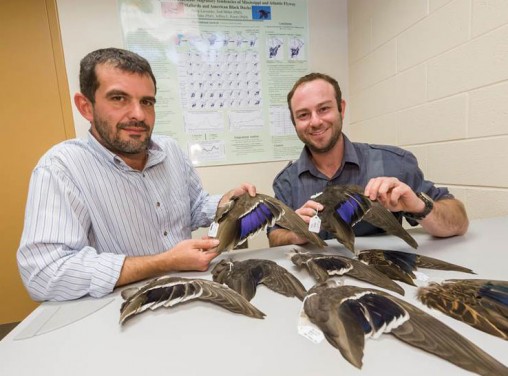
Research by Wright State biologists Jeffrey Peters, left, and Philip Lavretsky on the genetic makeup of ducks was published and highlighted in Auk: Advances in Ornithology, a prestigious scientific journal.
The mallard, the mottled duck, the American black duck, the Mexican duck.
Two Wright State biology researchers trying to determine what makes these four ducks different species had their paper published and highlighted in a prestigious scientific journal.
The research by Jeffrey Peters, Ph.D., associate professor of biology, and research associate Philip Lavretsky, Ph.D., was published by Auk: Advances in Ornithology, the official publication of the American Ornithologists’ Union and the premier North American journal of birds. The paper was an “Editor’s Pick,” only one of two out of about 25 papers in the issue.
While the mallard, with its familiar glossy green head, is abundant throughout North America, the mottled, Mexican and American black ducks have small or declining populations.
The number of American black ducks, for example, has declined by 50 percent since the 1950s. And mallards have been invading the ranges of the others and mating with them, resulting in hybrid ducks.
“When you start thinking about hybridizing causing a risk of extinction, it’s really important how we classify these four ducks,” Peters said. “Are these different species or are they morphs of the same species?”
Ducks are an important game animal. Mallards are the top game species, and the American black duck is the most sought-out waterfowl species on the East Coast.
“So a lot of people are interested in them, not only on the evolutionary side, but also in wildlife management,” Lavretsky said.
Peters believes the reason the three ducks look so different yet appear to have the same DNA is because changes in their shapes and coloring occurred rapidly and their genetic coding has yet to catch up.
One hypothesis is that “the mallard came to North America, and then the mottled, Mexican and American black duck budded off, and that’s why they are genetically similar,” Lavretsky said. This is why these duck species can so readily mate with each other.
The research that led to the paper by Peters and Lavretsky took them nearly four years.
The two researchers, who work in the College of Science and Mathematics, get duck wings from the U.S. Fish and Wildlife Service. They then take tiny pieces of the muscle, break up the cells, isolate the DNA, then use chemical reactions to make billions of copies of the DNA of interest (sort of like photocopying). The DNA is then sequenced using sophisticated biotechnology.
The ducks have been genetically studied since the 1980s by researchers, who have been unable to find genetic differences between them. But the researchers typically only looked at one part of the ducks’ DNA.
Peters and Lavretsky expanded the research to include 20 different regions of the DNA. But their research also could not discern any difference in the DNA, adding credence to the belief that speciation happened very recently.
“We still can’t tell these apart genetically even though you look at them and they’re very different,” Peters said.
However, Peters said other ongoing research is showing that there are key genes scattered throughout these ducks’ genomes that may maintain their differences in appearance.
“There is some evidence that there are in fact genetic differences and they are different species,” he said. “So there is a lot of work that still needs to be done.”
The next step for the two researchers is to use newer techniques to look at even more regions of the DNA.
“These new techniques let you to examine thousands of regions of DNA at a time,” Lavretsky said. “As you increase your coverage across the genome, you’re more likely to find those key differences.”

 Heavy metal learning
Heavy metal learning  State grants to bolster Wright State’s electric vehicle and advanced manufacturing training for students
State grants to bolster Wright State’s electric vehicle and advanced manufacturing training for students  Wright State partners with local universities, hospitals to expand mental health care for students
Wright State partners with local universities, hospitals to expand mental health care for students  Wright State students, first responders team up for Halloween event
Wright State students, first responders team up for Halloween event  Explore Wright State Day welcomes hundreds of future Raiders
Explore Wright State Day welcomes hundreds of future Raiders 